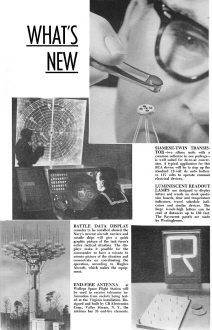|
April 1961 Radio-Electronics
 [Table of Contents] [Table of Contents]
Wax nostalgic about and learn from the history of early electronics.
See articles from Radio-Electronics,
published 1930-1988. All copyrights hereby acknowledged.
|
For a few years, Radio-Electronics
magazine ran a regular feature entitled "What's New - Pictorial Reports of New Developments,"
usually consisting of four or five photos of recent events, discoveries, inventions,
etc., in the wireless realm. This April 1961 issue was published in the era when
solid state devices were rapidly replacing vacuum tubes, so there was always something
mentioned about a transistor, diode, or even an integrated circuit. Antenna developments
appeared frequently, as did computer and display technologies. That 8-segment display
shown is not and LED, as it appears to be. It is an electroluminescent device called
a Rayescent panel, made by Westinghouse (note the Mercury dime used to indicate
the size). The only LEDs available in 1961 were infrared emitters, and those were
laboratory models. Optical wavelength LEDs became commercially available in the
mid-1960s.
Pictorial Reports of New Developments
 End-Fire Antenna at Wallops Space
Flight Station will be used to receive telemetry information from rockets being
tested at the Virginia installation. Designed and built by CB Electronics Corp.,
Valley Stream, N. Y., the antenna has 33 end-fire elements. End-Fire Antenna at Wallops Space
Flight Station will be used to receive telemetry information from rockets being
tested at the Virginia installation. Designed and built by CB Electronics Corp.,
Valley Stream, N. Y., the antenna has 33 end-fire elements.
Siamese-Twin Transistor - two silicon units with a common collector
in one package - is well suited for dc-to-ac conversion. A typical application for
this RCA device will be to step up the standard 12-volt DC auto battery to 117 volts
to operate common electrical devices.
Luminescent Readout Lamps are designed to display letters and
words on stock quotation boards, time and temperature indicators, travel schedule
indicators and similar devices. The large 4-inch-high letters can be read at distances
up to 150 feet. The Rayescent panels are made by Westinghouse.
Battle Data Display consoles to be installed aboard the Navy's
newest carriers and missile ships will give a quick graphic picture of the task
force's entire tactical situation. The displays male it possible for the commander
to have a minute to minute picture of the situation on coordinating the operation,
according to Hughes Aircraft, which makes the equipment.
Posted May 22, 2023
|





























